display FORD F-53 2018 User Guide
[x] Cancel search | Manufacturer: FORD, Model Year: 2018, Model line: F-53, Model: FORD F-53 2018Pages: 168, PDF Size: 3.02 MB
Page 99 of 168
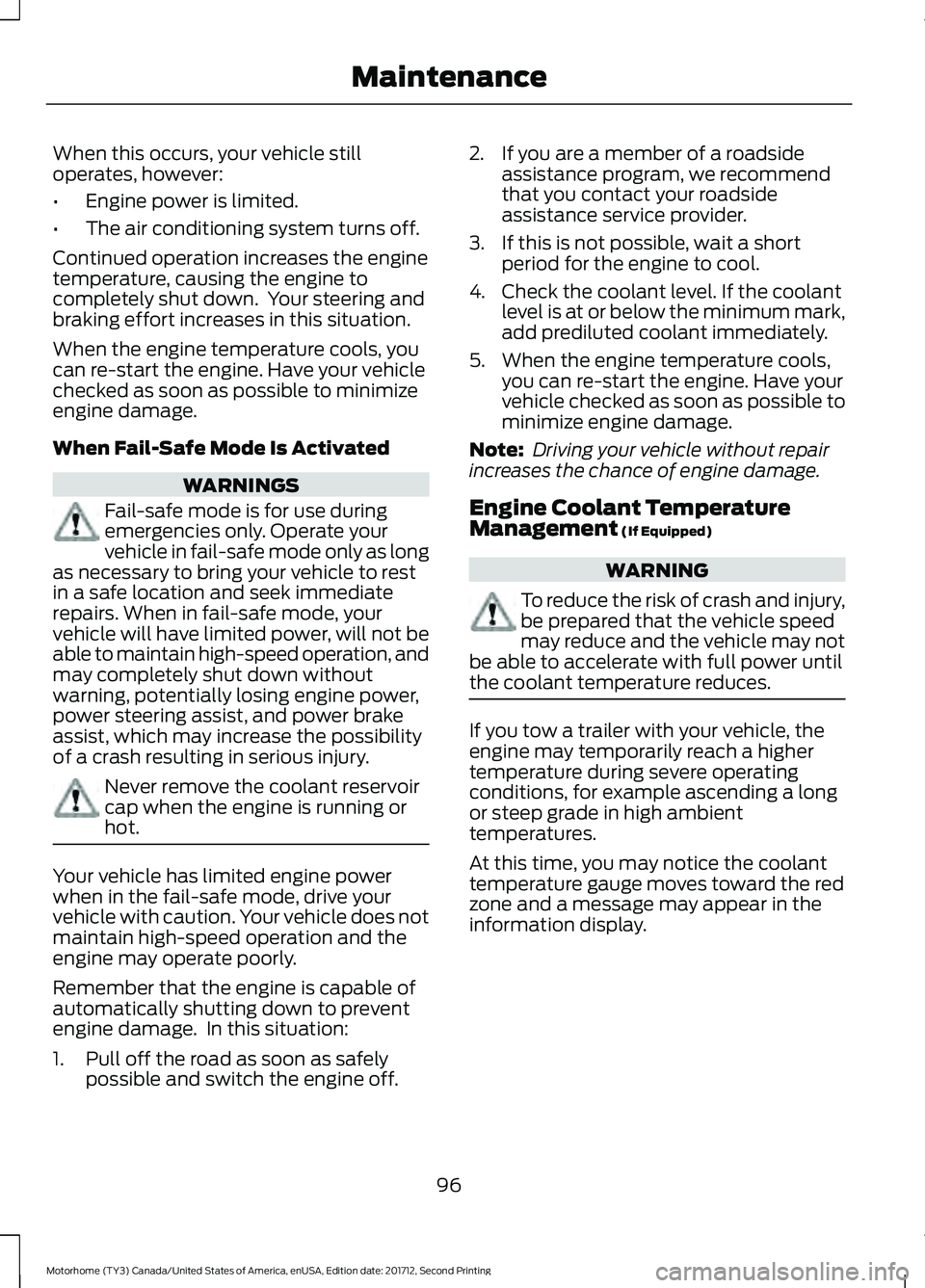
When this occurs, your vehicle still
operates, however:
•
Engine power is limited.
• The air conditioning system turns off.
Continued operation increases the engine
temperature, causing the engine to
completely shut down. Your steering and
braking effort increases in this situation.
When the engine temperature cools, you
can re-start the engine. Have your vehicle
checked as soon as possible to minimize
engine damage.
When Fail-Safe Mode Is Activated WARNINGS
Fail-safe mode is for use during
emergencies only. Operate your
vehicle in fail-safe mode only as long
as necessary to bring your vehicle to rest
in a safe location and seek immediate
repairs. When in fail-safe mode, your
vehicle will have limited power, will not be
able to maintain high-speed operation, and
may completely shut down without
warning, potentially losing engine power,
power steering assist, and power brake
assist, which may increase the possibility
of a crash resulting in serious injury. Never remove the coolant reservoir
cap when the engine is running or
hot.
Your vehicle has limited engine power
when in the fail-safe mode, drive your
vehicle with caution. Your vehicle does not
maintain high-speed operation and the
engine may operate poorly.
Remember that the engine is capable of
automatically shutting down to prevent
engine damage. In this situation:
1. Pull off the road as soon as safely
possible and switch the engine off. 2. If you are a member of a roadside
assistance program, we recommend
that you contact your roadside
assistance service provider.
3. If this is not possible, wait a short period for the engine to cool.
4. Check the coolant level. If the coolant level is at or below the minimum mark,
add prediluted coolant immediately.
5. When the engine temperature cools, you can re-start the engine. Have your
vehicle checked as soon as possible to
minimize engine damage.
Note: Driving your vehicle without repair
increases the chance of engine damage.
Engine Coolant Temperature
Management (If Equipped) WARNING
To reduce the risk of crash and injury,
be prepared that the vehicle speed
may reduce and the vehicle may not
be able to accelerate with full power until
the coolant temperature reduces. If you tow a trailer with your vehicle, the
engine may temporarily reach a higher
temperature during severe operating
conditions, for example ascending a long
or steep grade in high ambient
temperatures.
At this time, you may notice the coolant
temperature gauge moves toward the red
zone and a message may appear in the
information display.
96
Motorhome (TY3) Canada/United States of America, enUSA, Edition date: 201712, Second Printing Maintenance
Page 100 of 168
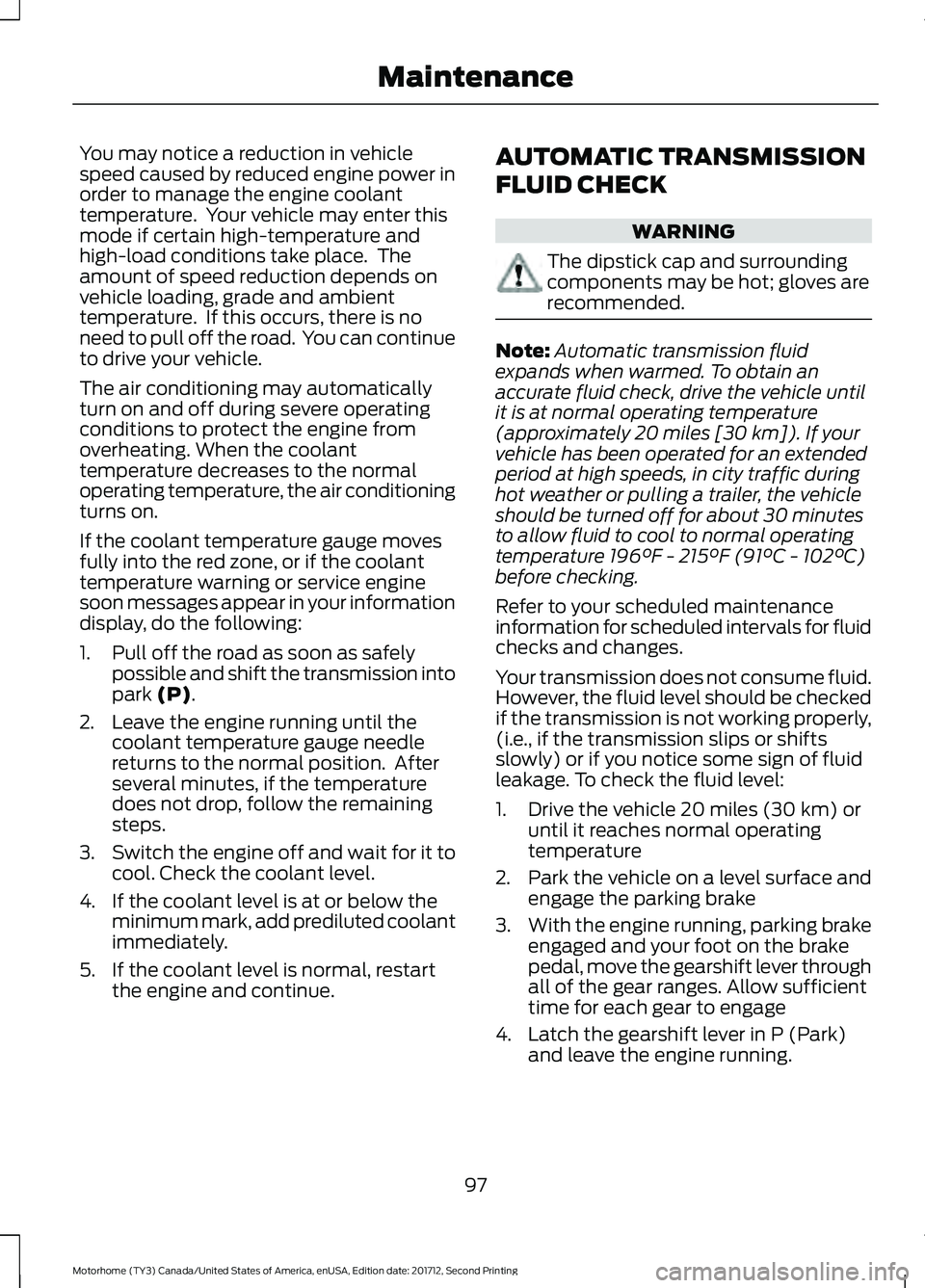
You may notice a reduction in vehicle
speed caused by reduced engine power in
order to manage the engine coolant
temperature. Your vehicle may enter this
mode if certain high-temperature and
high-load conditions take place. The
amount of speed reduction depends on
vehicle loading, grade and ambient
temperature. If this occurs, there is no
need to pull off the road. You can continue
to drive your vehicle.
The air conditioning may automatically
turn on and off during severe operating
conditions to protect the engine from
overheating. When the coolant
temperature decreases to the normal
operating temperature, the air conditioning
turns on.
If the coolant temperature gauge moves
fully into the red zone, or if the coolant
temperature warning or service engine
soon messages appear in your information
display, do the following:
1. Pull off the road as soon as safely
possible and shift the transmission into
park (P).
2. Leave the engine running until the coolant temperature gauge needle
returns to the normal position. After
several minutes, if the temperature
does not drop, follow the remaining
steps.
3. Switch the engine off and wait for it to
cool. Check the coolant level.
4. If the coolant level is at or below the minimum mark, add prediluted coolant
immediately.
5. If the coolant level is normal, restart the engine and continue. AUTOMATIC TRANSMISSION
FLUID CHECK WARNING
The dipstick cap and surrounding
components may be hot; gloves are
recommended.
Note:
Automatic transmission fluid
expands when warmed. To obtain an
accurate fluid check, drive the vehicle until
it is at normal operating temperature
(approximately 20 miles [30 km]). If your
vehicle has been operated for an extended
period at high speeds, in city traffic during
hot weather or pulling a trailer, the vehicle
should be turned off for about 30 minutes
to allow fluid to cool to normal operating
temperature 196°F - 215°F (91°C - 102°C)
before checking.
Refer to your scheduled maintenance
information for scheduled intervals for fluid
checks and changes.
Your transmission does not consume fluid.
However, the fluid level should be checked
if the transmission is not working properly,
(i.e., if the transmission slips or shifts
slowly) or if you notice some sign of fluid
leakage. To check the fluid level:
1. Drive the vehicle 20 miles (30 km) or until it reaches normal operating
temperature
2. Park the vehicle on a level surface and
engage the parking brake
3. With the engine running, parking brake
engaged and your foot on the brake
pedal, move the gearshift lever through
all of the gear ranges. Allow sufficient
time for each gear to engage
4. Latch the gearshift lever in P (Park) and leave the engine running.
97
Motorhome (TY3) Canada/United States of America, enUSA, Edition date: 201712, Second Printing Maintenance
Page 139 of 168
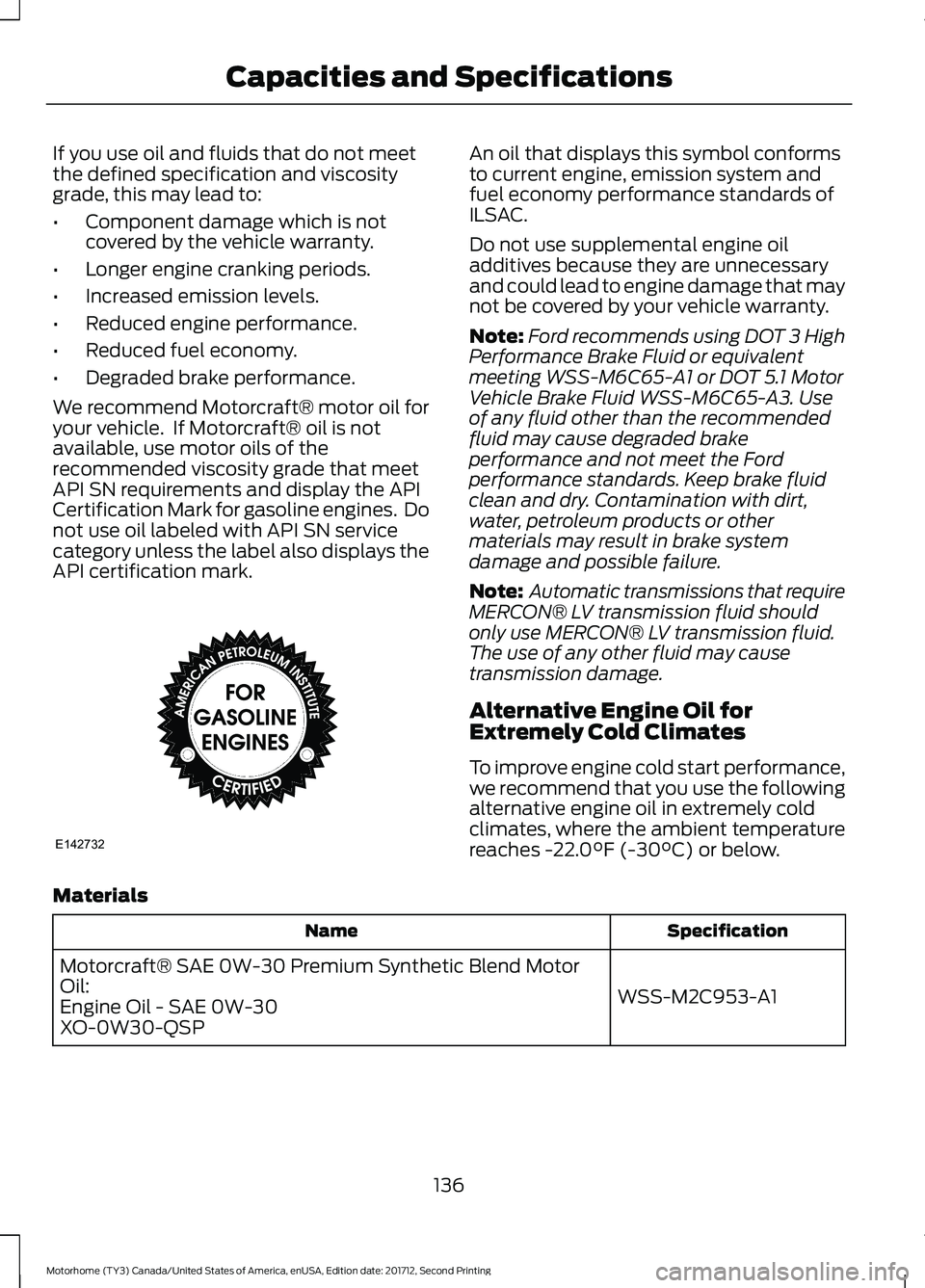
If you use oil and fluids that do not meet
the defined specification and viscosity
grade, this may lead to:
•
Component damage which is not
covered by the vehicle warranty.
• Longer engine cranking periods.
• Increased emission levels.
• Reduced engine performance.
• Reduced fuel economy.
• Degraded brake performance.
We recommend Motorcraft® motor oil for
your vehicle. If Motorcraft® oil is not
available, use motor oils of the
recommended viscosity grade that meet
API SN requirements and display the API
Certification Mark for gasoline engines. Do
not use oil labeled with API SN service
category unless the label also displays the
API certification mark. An oil that displays this symbol conforms
to current engine, emission system and
fuel economy performance standards of
ILSAC.
Do not use supplemental engine oil
additives because they are unnecessary
and could lead to engine damage that may
not be covered by your vehicle warranty.
Note:
Ford recommends using DOT 3 High
Performance Brake Fluid or equivalent
meeting WSS-M6C65-A1 or DOT 5.1 Motor
Vehicle Brake Fluid WSS-M6C65-A3. Use
of any fluid other than the recommended
fluid may cause degraded brake
performance and not meet the Ford
performance standards. Keep brake fluid
clean and dry. Contamination with dirt,
water, petroleum products or other
materials may result in brake system
damage and possible failure.
Note: Automatic transmissions that require
MERCON® LV transmission fluid should
only use MERCON® LV transmission fluid.
The use of any other fluid may cause
transmission damage.
Alternative Engine Oil for
Extremely Cold Climates
To improve engine cold start performance,
we recommend that you use the following
alternative engine oil in extremely cold
climates, where the ambient temperature
reaches -22.0°F (-30°C) or below.
Materials Specification
Name
WSS-M2C953-A1
Motorcraft® SAE 0W-30 Premium Synthetic Blend Motor
Oil:
Engine Oil - SAE 0W-30
XO-0W30-QSP
136
Motorhome (TY3) Canada/United States of America, enUSA, Edition date: 201712, Second Printing Capacities and SpecificationsE142732
Page 165 of 168
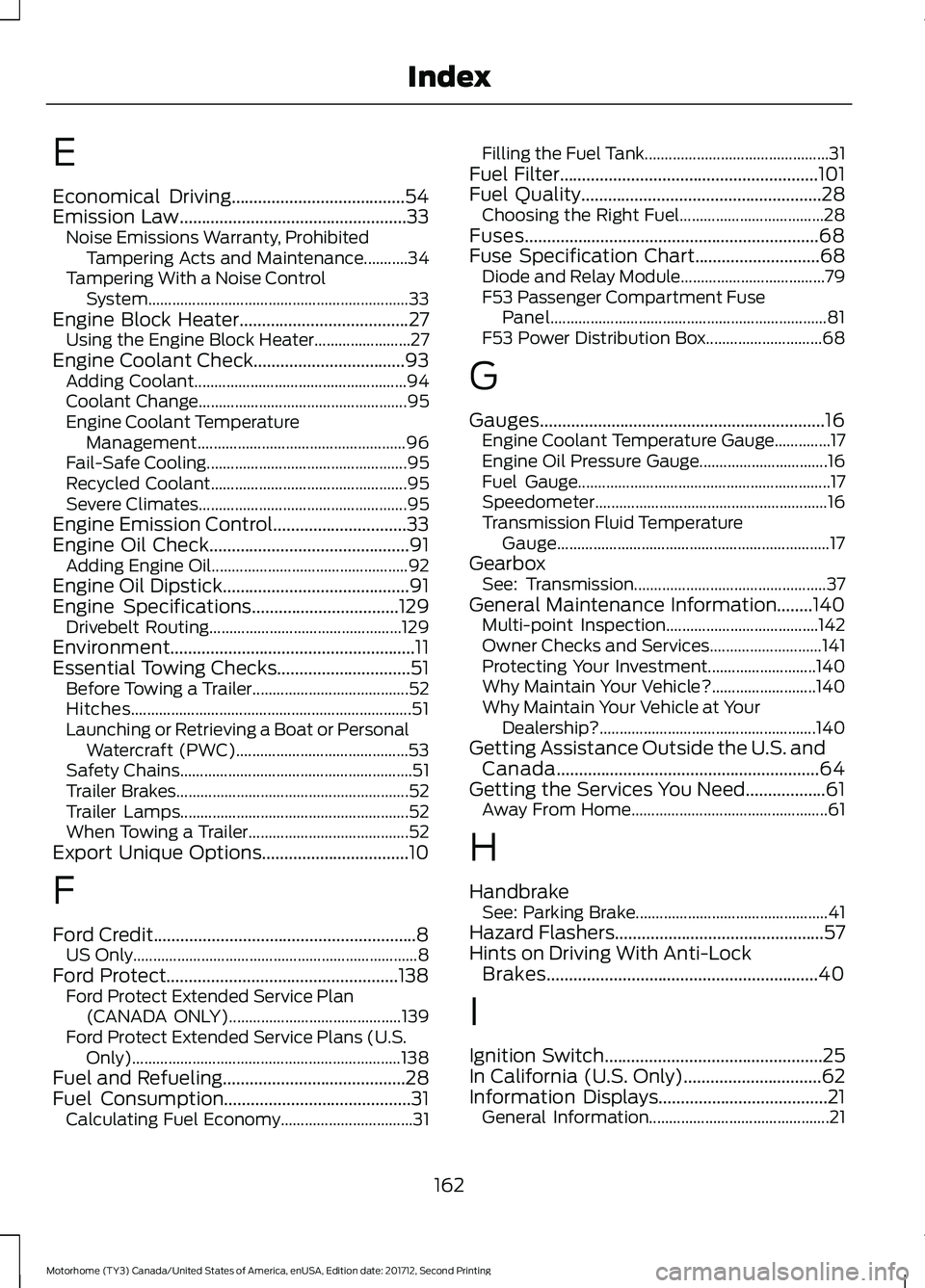
E
Economical Driving.......................................54
Emission Law...................................................33
Noise Emissions Warranty, Prohibited
Tampering Acts and Maintenance...........34
Tampering With a Noise Control System................................................................. 33
Engine Block Heater
......................................27
Using the Engine Block Heater........................ 27
Engine Coolant Check..................................93 Adding Coolant..................................................... 94
Coolant Change.................................................... 95
Engine Coolant Temperature Management.................................................... 96
Fail-Safe Cooling.................................................. 95
Recycled Coolant................................................. 95
Severe Climates.................................................... 95
Engine Emission Control..............................33
Engine Oil Check.............................................91 Adding Engine Oil................................................. 92
Engine Oil Dipstick..........................................91
Engine Specifications.................................129 Drivebelt Routing................................................ 129
Environment.......................................................11
Essential Towing Checks..............................51 Before Towing a Trailer....................................... 52
Hitches...................................................................... 51
Launching or Retrieving a Boat or Personal Watercraft (PWC)........................................... 53
Safety Chains.......................................................... 51
Trailer Brakes.......................................................... 52
Trailer Lamps......................................................... 52
When Towing a Trailer........................................ 52
Export Unique Options.................................10
F
Ford Credit...........................................................8 US Only....................................................................... 8
Ford Protect....................................................138 Ford Protect Extended Service Plan
(CANADA ONLY)........................................... 139
Ford Protect Extended Service Plans (U.S. Only)................................................................... 138
Fuel and Refueling
.........................................28
Fuel Consumption..........................................31
Calculating Fuel Economy................................. 31Filling the Fuel Tank..............................................
31
Fuel Filter
..........................................................101
Fuel Quality......................................................28
Choosing the Right Fuel.................................... 28
Fuses..................................................................68
Fuse Specification Chart............................68 Diode and Relay Module.................................... 79
F53 Passenger Compartment Fuse Panel..................................................................... 81
F53 Power Distribution Box............................. 68
G
Gauges................................................................16 Engine Coolant Temperature Gauge..............17
Engine Oil Pressure Gauge................................ 16
Fuel Gauge............................................................... 17
Speedometer.......................................................... 16
Transmission Fluid Temperature Gauge.................................................................... 17
Gearbox See: Transmission................................................ 37
General Maintenance Information........140 Multi-point Inspection...................................... 142
Owner Checks and Services............................ 141
Protecting Your Investment........................... 140
Why Maintain Your Vehicle?.......................... 140
Why Maintain Your Vehicle at Your Dealership?...................................................... 140
Getting Assistance Outside the U.S. and Canada...........................................................64
Getting the Services You Need..................61 Away From Home................................................. 61
H
Handbrake See: Parking Brake................................................ 41
Hazard Flashers
...............................................57
Hints on Driving With Anti-Lock Brakes.............................................................40
I
Ignition Switch
.................................................25
In California (U.S. Only)...............................62
Information Displays
......................................21
General Information............................................. 21
162
Motorhome (TY3) Canada/United States of America, enUSA, Edition date: 201712, Second Printing Index
Page 166 of 168
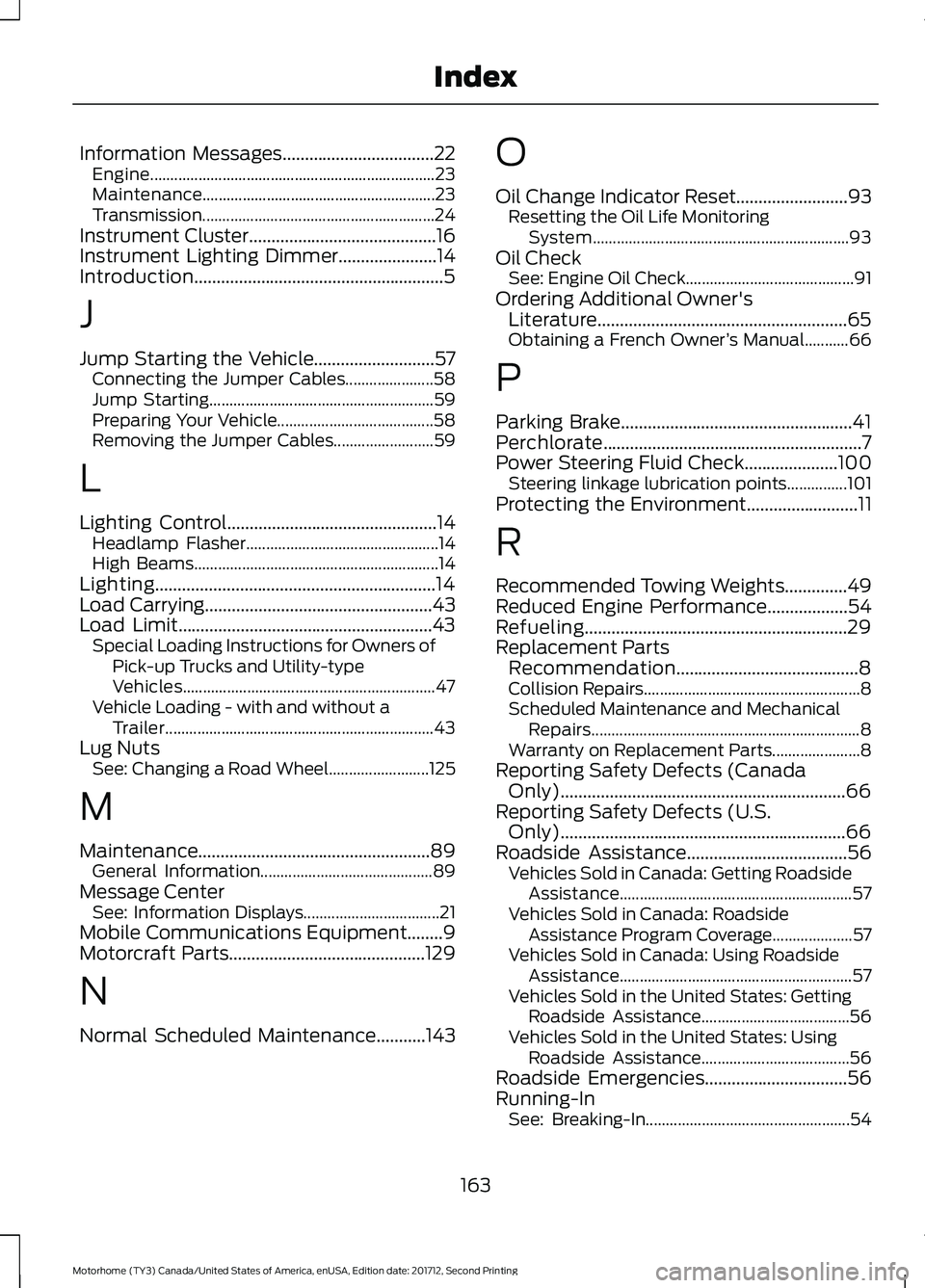
Information Messages..................................22
Engine....................................................................... 23
Maintenance.......................................................... 23
Transmission.......................................................... 24
Instrument Cluster..........................................16
Instrument Lighting Dimmer......................14
Introduction........................................................5
J
Jump Starting the Vehicle...........................57 Connecting the Jumper Cables...................... 58
Jump Starting........................................................ 59
Preparing Your Vehicle....................................... 58
Removing the Jumper Cables......................... 59
L
Lighting Control
...............................................14
Headlamp Flasher................................................ 14
High Beams............................................................. 14
Lighting...............................................................14
Load Carrying
...................................................43
Load Limit.........................................................43 Special Loading Instructions for Owners of
Pick-up Trucks and Utility-type
Vehicles............................................................... 47
Vehicle Loading - with and without a Trailer................................................................... 43
Lug Nuts See: Changing a Road Wheel......................... 125
M
Maintenance....................................................89 General Information........................................... 89
Message Center See: Information Displays.................................. 21
Mobile Communications Equipment
........9
Motorcraft Parts............................................129
N
Normal Scheduled Maintenance...........143 O
Oil Change Indicator Reset.........................93
Resetting the Oil Life Monitoring
System................................................................ 93
Oil Check See: Engine Oil Check.......................................... 91
Ordering Additional Owner's Literature........................................................65
Obtaining a French Owner ’s Manual...........66
P
Parking Brake....................................................41
Perchlorate..........................................................7
Power Steering Fluid Check.....................100 Steering linkage lubrication points...............101
Protecting the Environment.........................11
R
Recommended Towing Weights
..............49
Reduced Engine Performance..................54
Refueling...........................................................29
Replacement Parts Recommendation.........................................8
Collision Repairs...................................................... 8
Scheduled Maintenance and Mechanical Repairs................................................................... 8
Warranty on Replacement Parts...................... 8
Reporting Safety Defects (Canada Only)................................................................66
Reporting Safety Defects (U.S. Only)................................................................66
Roadside Assistance....................................56 Vehicles Sold in Canada: Getting Roadside
Assistance.......................................................... 57
Vehicles Sold in Canada: Roadside Assistance Program Coverage.................... 57
Vehicles Sold in Canada: Using Roadside Assistance.......................................................... 57
Vehicles Sold in the United States: Getting Roadside Assistance..................................... 56
Vehicles Sold in the United States: Using Roadside Assistance..................................... 56
Roadside Emergencies
................................56
Running-In See: Breaking-In................................................... 54
163
Motorhome (TY3) Canada/United States of America, enUSA, Edition date: 201712, Second Printing Index